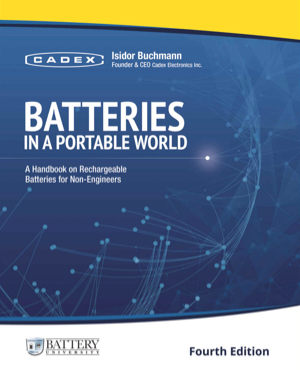It is interesting to observe that batteries cared for by a single user generally last longer than those operating in an open fleet system where everyone has access but no one is responsible. A personal user is one who operates a mobile phone, a laptop or digital camera for business or pleasure. He or she usually cares for the battery and makes all efforts to follow the recommended guidelines. With time, the user gets to know the battery like a good friend, and critical failures are rare because the owner adjusts to the changing condition, lowers expectations and replaces the pack when it becomes a nuisance.
The desire to care for the batteries is not witnessed among fleet users. The packs belong to a pool of unknown batteries and operate in a sharing arrangement. While an individual user can live with reduced runtime, the fleet operators have little attachment to the battery and show no patience with anything that is less than perfect. They grab a battery from the charger and expect it to last through the shift. At the end of the day, the battery is plugged into the charger again, ready for the next user. Having serviced batteries for fleet users for many years, I noticed shorter service life on fleet packs than those for personal use.
How can fleet batteries be made to last longer? I made an interesting observation on battery life in comparing two defense organizations, the US Army and the Dutch Army, both of which I had the pleasure of visiting. The armies in question use fleet batteries and deploy them similarly with the following exception.
The US Army issues batteries without a maintenance program. If the battery fails, another pack is released, no questions asked. Little or no care is taken and the failure rate is high. The Dutch Army, on the other hand, has moved away from the open fleet system by making the soldiers responsible for their batteries. The entrusted packs become part of their personal belongings, similar to food and clothing. The army made the change to reduce operational costs and improve reliability.
The results are startling. Since the Dutch Army adapted this new regime, the failure rate has dropped considerably and battery performance has increased. Unexpected downtime has almost been eliminated.
I should mention that the Dutch Army used nickel-cadmium batteries at the time of the study. Each pack received periodic maintenance on a Cadex battery analyzer to prolong service life. Batteries that did not meet the required 80 percent target capacity were reconditioned, and those failing to meet the target setting were replaced. Meanwhile, the US Army had switched to nickel-metal-hydride, a chemistry that is known to offer higher capacity but shorter service life. Today, both armies use lithium-ion on their new equipment.
Public safety organizations use a mix of NiCd, NiMH and Li-ion. Checking with a fire department to find out which chemistry works best, I learned that Li-ion is indeed superior. After 15 months of use, the Li-ion batteries tested on a Cadex battery analyzer still showed 92–95 percent capacity, and the users are confident that the batteries can be used reliably for two to three full shifts on a single charge. Such performance would not have been possible with nickel-based batteries. But battery breakdowns still occur and the failure rate continues to be relatively high in fleet use. This might be user-related, and the Dutch Army model of assigning a battery as a personal belonging might solve this problem.
The lighter weight and longer runtime of Li-ion also offers noticeable advantages for power tools. Stores say that Li-ion batteries generate fewer returns than nickel-based packs, and this is in part due to the protection circuit that prevents reverse polarization on overload. Medical instruments are also switching to Li-ion but regulatory conditions make the change cumbersome. Bureaucracy can indeed stifle new technology rather than promote it.

Comments
Looking for comments from the previous website?
Comments from the previous website are not compatible with our new commenting system but we have preserved them so our users can still reference and make use the information in them.
